1998 CADILLAC SEVILLE maintenance
[x] Cancel search: maintenancePage 277 of 378
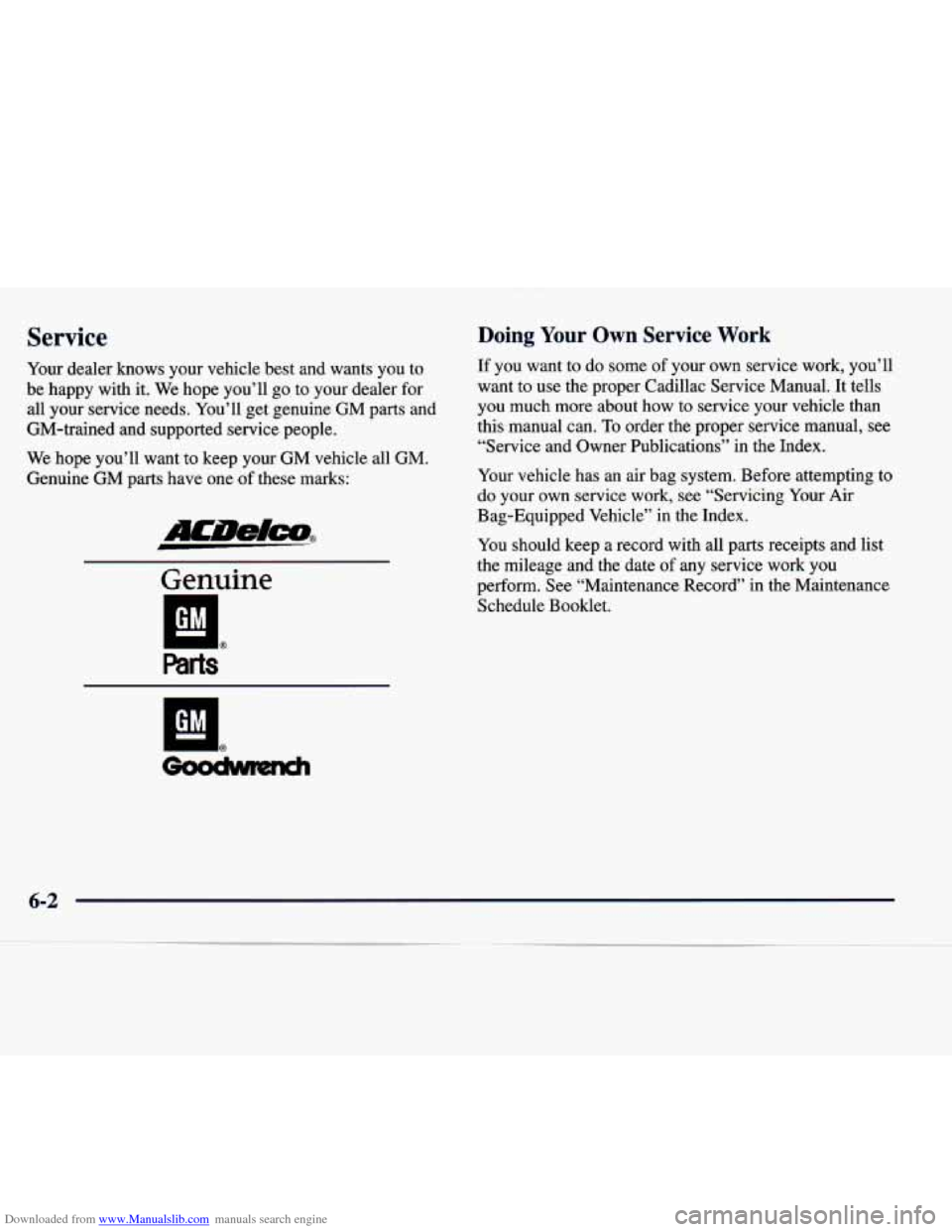
Downloaded from www.Manualslib.com manuals search engine Service
Your dealer knows your vehicle best and wants you to
be happy with it. We hope you’ll go to your dealer for
all your service needs. You’ll get genuine GM parts and
GM-trained and supported service people.
We hope you’ll want to keep your GM vehicle all GM.
Genuine
GM parts have one of these marks:
Genuine
Doing Your Own Service Work
If you want to do some of your own service work, you’ll
want to use the proper Cadillac Service Manual. It tells
you much more about how to service your vehicle than
this manual can.
To order the proper service manual, see
“Service and Owner Publications” in the Index.
Your vehicle has an air bag system. Before attempting to
do your own service work, see “Servicing Your Air
Bag-Equipped Vehicle” in the Index.
You should keep a record with all parts receipts and list
the mileage and the date of any service work you
perform. See “Maintenance Record” in the Maintenance
Schedule Booklet.
6-2
Page 278 of 378
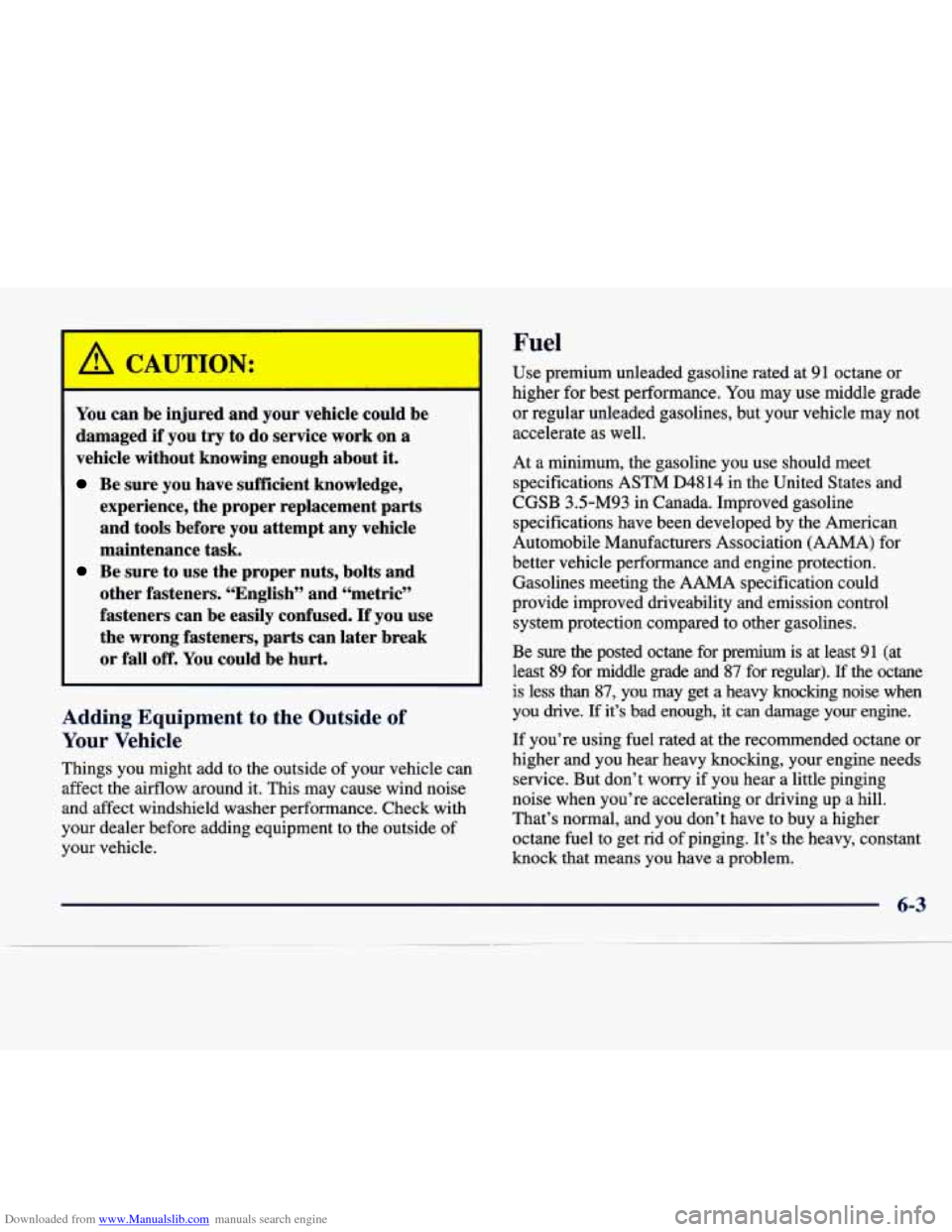
Downloaded from www.Manualslib.com manuals search engine Fuel
You can be injured and your vehicle could be
damaged if you
try to do service work on a
vehicle without knowing enough about it.
Be sure you have sufficient knowledge,
experience, the proper replacement parts
and tools before you attempt any vehicle
maintenance task.
Be sure to use the proper nuts, bolts and
other fasteners. “English” and “metric”
fasteners can be easily confused. If you use
the wrong fasteners, parts can later break
or fall off. You could be hurt.
Adding Equipment to the Outside of
Your Vehicle
Things you might add to the outside of your vehicle can
affect the airflow around it. This may cause wind noise
and affect windshield washer performance. Check with
your dealer before adding equipment to the outside of
your vehicle. Use premium unleaded gasoline rated at
91 octane or
higher for best performance. You may
use middle grade
or regular unleaded gasolines, but your vehicle may not
accelerate as well.
At
a minimum, the gasoline you use should meet
specifications
ASTM D4814 in the United States and
CGSB 3.5-M93 in Canada. Improved gasoline
specifications have been developed by the American
Automobile Manufacturers Association
(AAMA) for
better vehicle performance and engine protection.
Gasolines meeting the AAMA specification could
provide improved driveability and emission control
system protection compared
to other gasolines.
Be sure the posted octane for premium is at least 91 (at
least
89 for middle grade and 87 for regular). If the octane
is less than 87, you may get a heavy knocking noise when
you
drive. If it’s bad enough, it can darnage your engine.
If you’re using fuel rated at the recommended octane or
higher and you hear heavy knocking, your engine needs service. But don’t worry if you hear a little pinging
noise when you’re accelerating or driving up a hill.
That’s normal, and you don’t have to buy a higher octane fuel
to get rid of pinging. It’s the heavy, constant
knock that means you have a problem.
Page 292 of 378
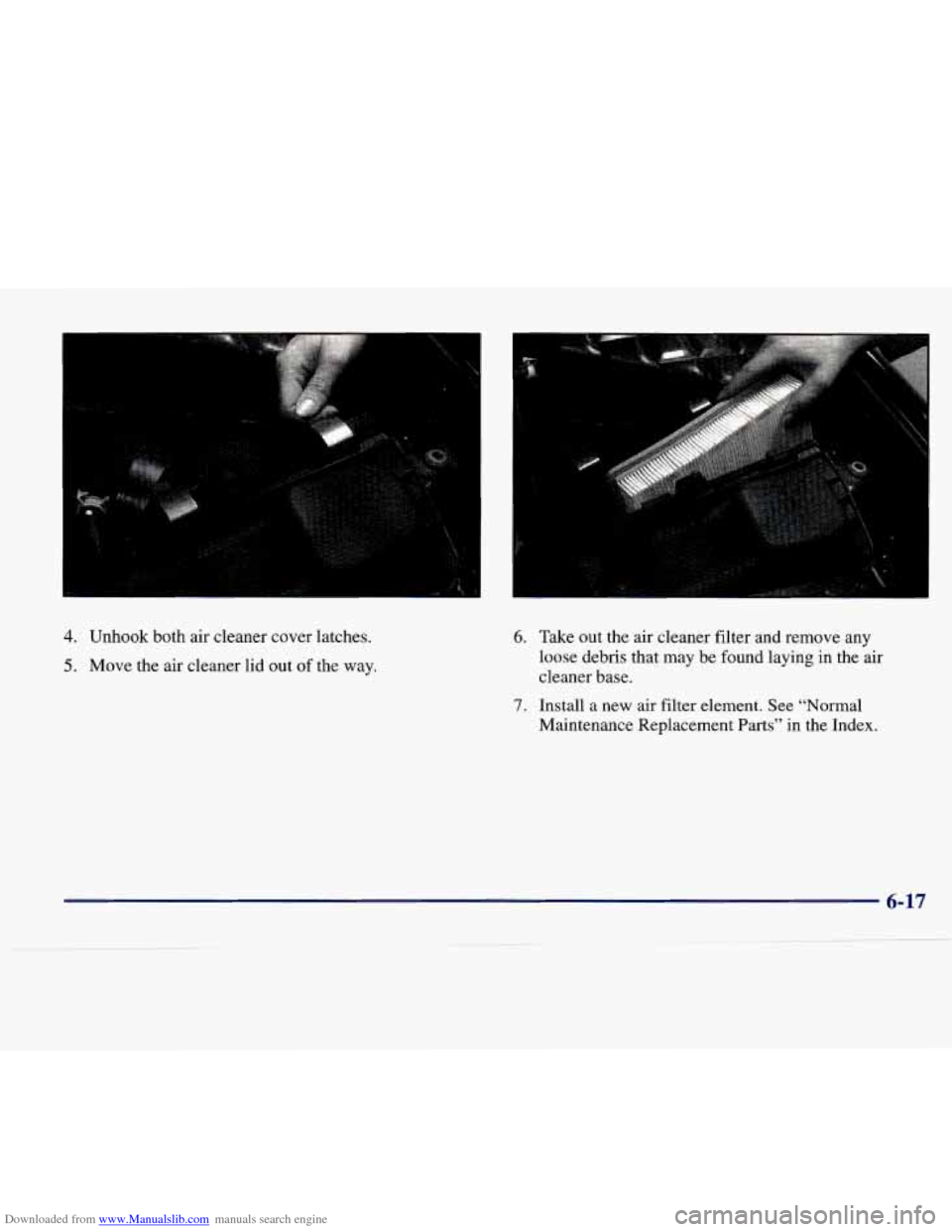
Downloaded from www.Manualslib.com manuals search engine 4. Unhook both air cleaner cover latches.
5. Move the air cleaner lid out of the way.
6. Take out the air cleaner filter and remove any
loose debris that may be found laying
in the air
cleaner base.
7. Install a new air filter element. See “Normal
Maintenance Replacement
Parts” in the Index.
Page 293 of 378
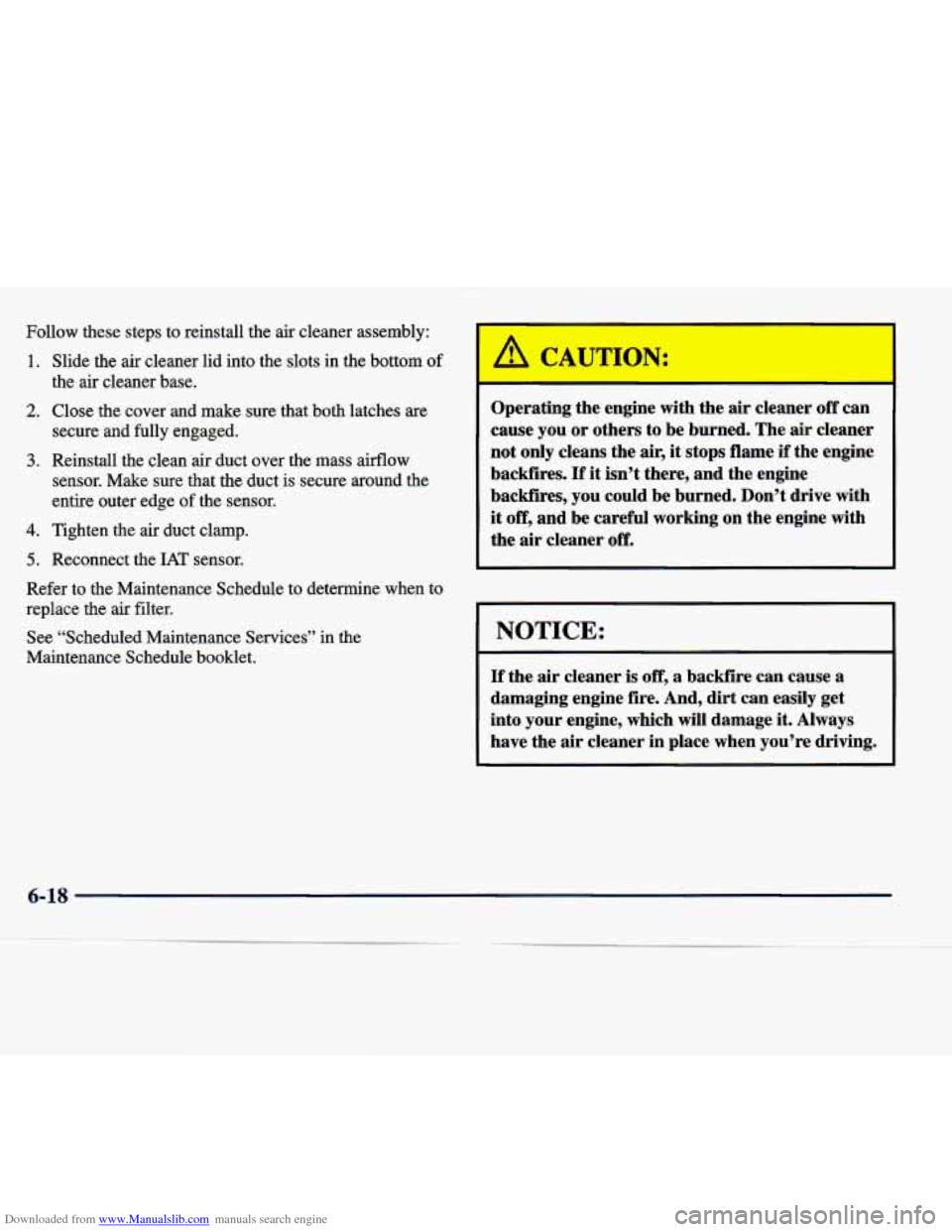
Downloaded from www.Manualslib.com manuals search engine Follow these steps to reinstall the air cleaner assembly:
1.
2.
3.
4.
5.
Slide the air cleaner lid into the slots in the bottom of
the air cleaner base.
Close the cover and make sure that both latches are
secure and fully engaged.
Reinstall the clean air duct over the mass airflow
sensor. Make sure that the duct is secure around the
entire outer edge of the sensor.
Tighten the air duct clamp. Reconnect the
MI’ sensor.
Refer to the Maintenance Schedule
to determine when to
replace the air filter.
See “Scheduled Maintenance Services” in the
Maintenance Schedule booklet.
’ A ( JTION:
Operating the engine with the air cleaner off can
cause you or others to be burned, The
air cleaner
not only cleans the
air, it stops flame if the engine
backfires.
If it isn’t there, and the engine
backfires, you could be burned. Don’t drive with
it
off, and be careful working on the engine with
the air cleaner off.
I NOTICE:
If the air cleaner is off, a backfire can cause a
damaging engine fire. And, dirt can easily get
into your engine, which will damage it. Always
have the air cleaner in place when you’re driving.
6-18
Page 294 of 378
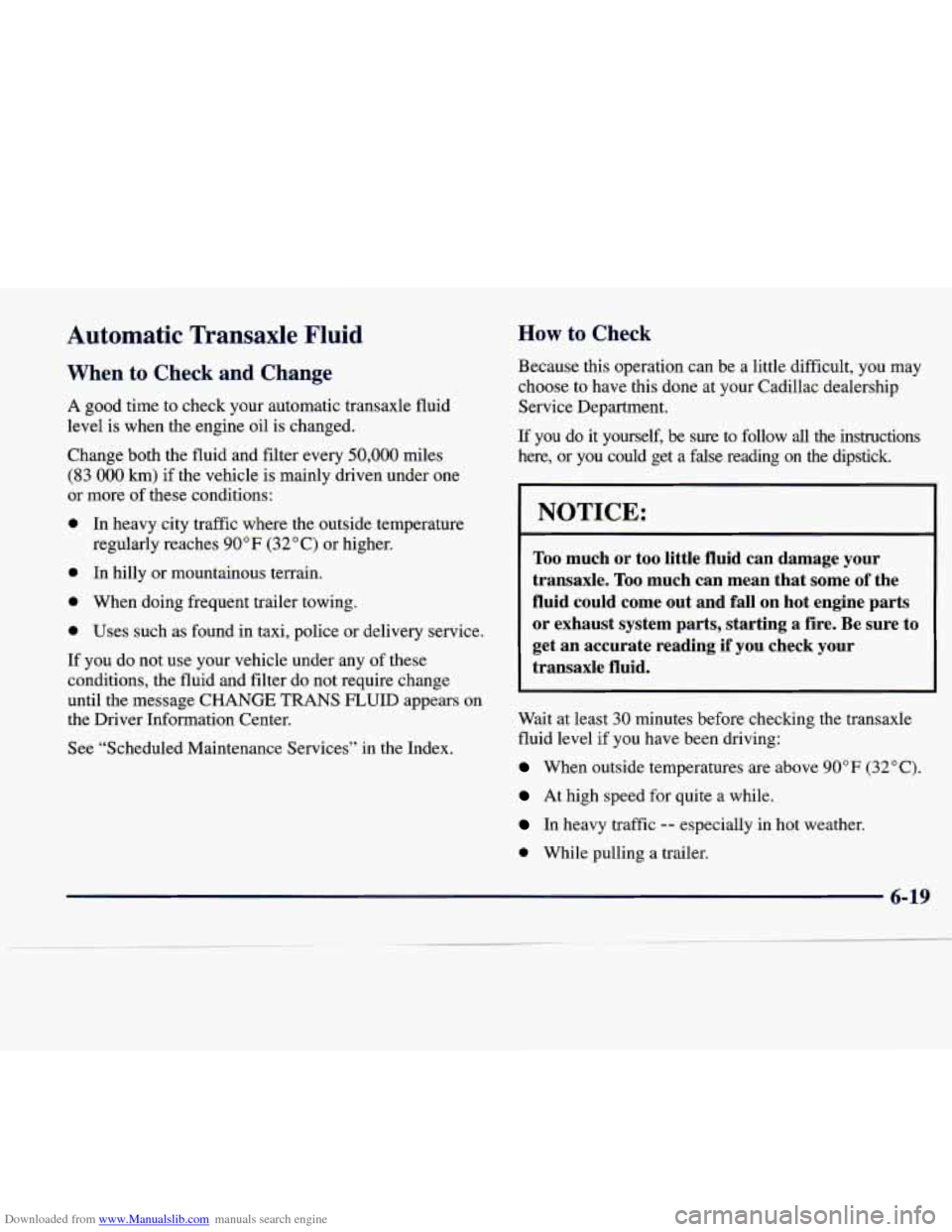
Downloaded from www.Manualslib.com manuals search engine Automatic Transaxle Fluid
When to Check and Change
A good time to check your automatic transaxle fluid
level is when the engine oil is changed.
Change both the fluid and filter every
50,000 miles
(83 000 km) if the vehicle is mainly driven under one
or more of these conditions:
0 In heavy city traffic where the outside temperature
0 In hilly or mountainous terrain. regularly reaches
90 OF (32 O C) or higher.
0 When doing frequent trailer towing.
0 Uses such as found in taxi, police or delivery service.
If you do not use your vehicle under any of these
conditions, the fluid and filter do not require change
until the message CHANGE
TRANS FLUID appears on
the Driver Information Center.
See “Scheduled Maintenance Services” in the Index.
How to Check
Because this operation can be a little difficult, you may
choose to have this done
at your Cadillac dealership
Service Department.
If you do it yourself, be sure to follow all the instructions
here, or you could get a false reading on the dipstick.
1 NOTICE: - -1
Too much or too little fluid can damage your
transaxle.
Too much can mean that some of the
fluid could come out and fall on hot engine parts or exhaust system parts, starting a fire. Be sure to
get an accurate reading if you check your
transaxle fluid.
Wait at least 30 minutes before checking the transaxle
fluid level if you have been driving:
When outside temperatures are above 90°F (32°C).
At high speed for quite a while.
In heavy traffic -- especially in hot weather.
0 While pulling a trailer.
6-19
Page 296 of 378
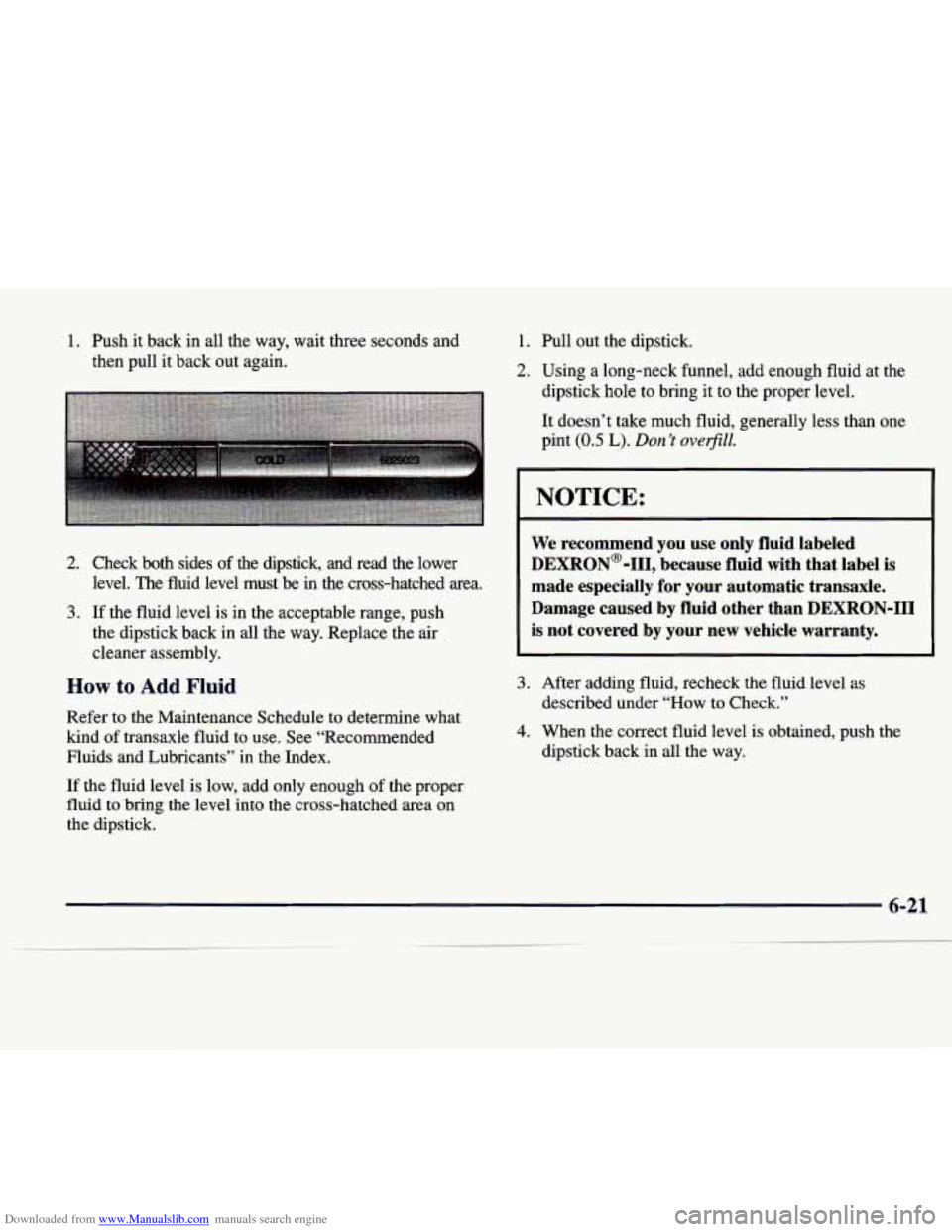
Downloaded from www.Manualslib.com manuals search engine 1. Push it back in all the way, wait three seconds and
then pull it back out again.
2. Check both sides of the dipstick, and read the lower
3. If the fluid level is in the acceptable range, push
the dipstick back in all the way. Replace the air
cleaner assembly. level. The fluid level must be in the cross-hatched area.
How to Add Fluid
Refer to the Maintenance Schedule to determine what
kind of transaxle fluid
to use. See “Recommended
Fluids and Lubricants” in the Index.
If the fluid level is low, add only enough of the proper
fluid to bring the level into the cross-hatched area on
the dipstick.
1. Pull out the dipstick.
2. Using a long-neck funnel, add enough fluid at the
dipstick hole
to bring it to the proper level.
It doesn’t take much fluid, generally less than one
pint
(0.5 L). Don’t overfill.
I NOTICE: I
We recommend you use only fluid labeled
DEXRON@-111, because fluid with that label is
made especially
for your automatic transaxle.
Damage caused by fluid other than DEXRON-I11
is not covered by your new vehicle warranty.
3. After adding fluid, recheck the fluid level as
described under
“How to Check.”
4. When the correct fluid level is obtained, push the
dipstick back in all the way.
Page 301 of 378
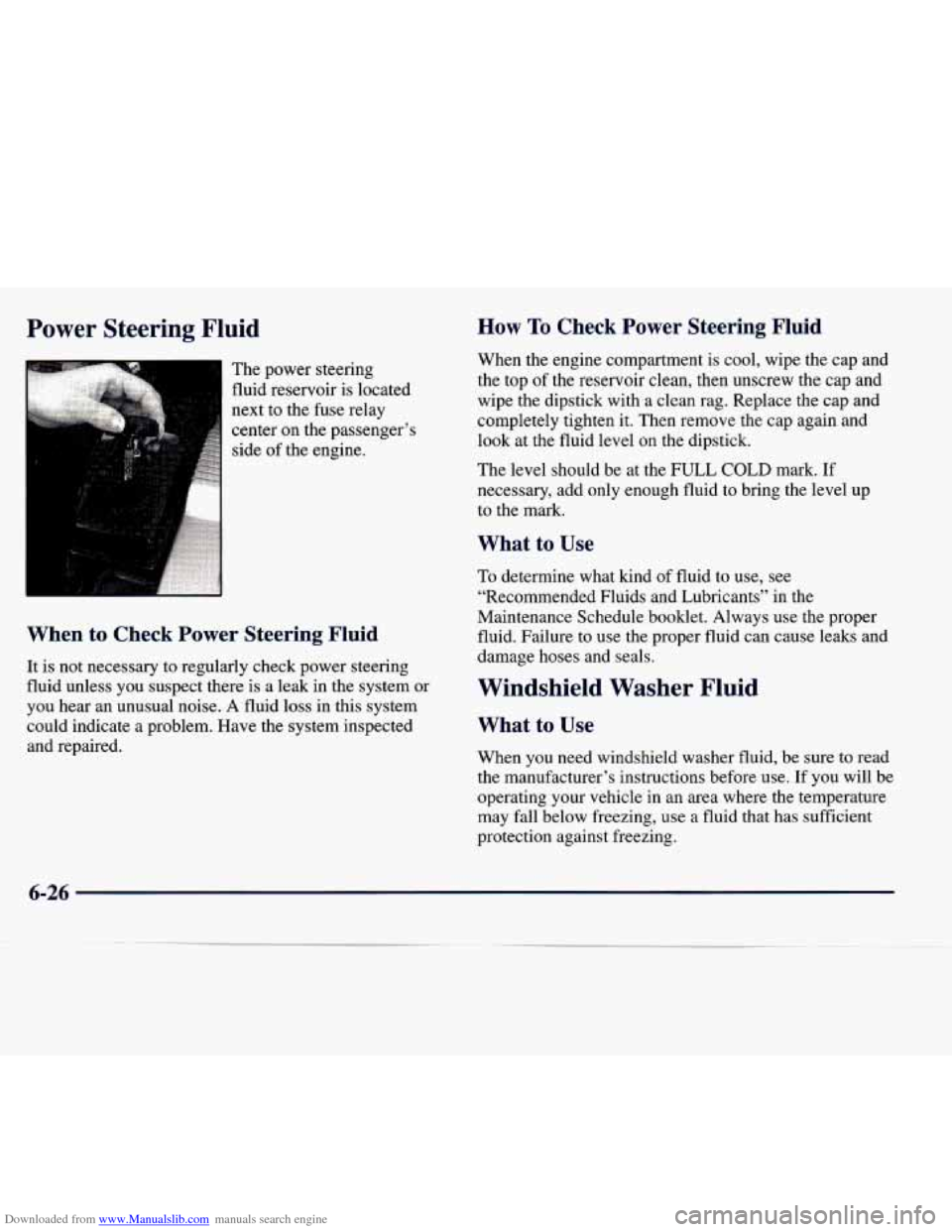
Downloaded from www.Manualslib.com manuals search engine Power Steering Fluid
The power steering
fluid reservoir is located
next to the fuse relay
center on the passenger’s
side of the engine.
When to Check Power Steering Fluid
It is not necessary to regularly check power steering
fluid unless you suspect there
is a leak in the system or
you hear an unusual noise. A fluid loss in this system
could indicate a problem. Have the system inspected
and repaired.
How To Check Power Steering Fluid
When the engine compartment is cool, wipe the cap and
the top of the reservoir clean, then unscrew the cap and
wipe the dipstick with a clean rag. Replace the cap and
completely tighten it. Then remove the cap again and
look at the fluid level on the dipstick.
The level should be at the
FULL COLD mark. If
necessary, add only enough fluid
to bring the level up
to the mark.
What to Use
To determine what kind of fluid to use, see
“Recommended Fluids and Lubricants” in the
Maintenance Schedule booklet. Always use the proper
fluid, Failure
to use the proper fluid can cause leaks and
damage hoses and seals.
Windshield Washer Fluid
What to Use
When you need windshield washer fluid, be sure to read
the manufacturer’s instructions before use.
If you will be
operating your vehicle
in an area where the temperature
may fall below freezing, use a fluid that has sufficient
protection against freezing.
6-26
Page 306 of 378
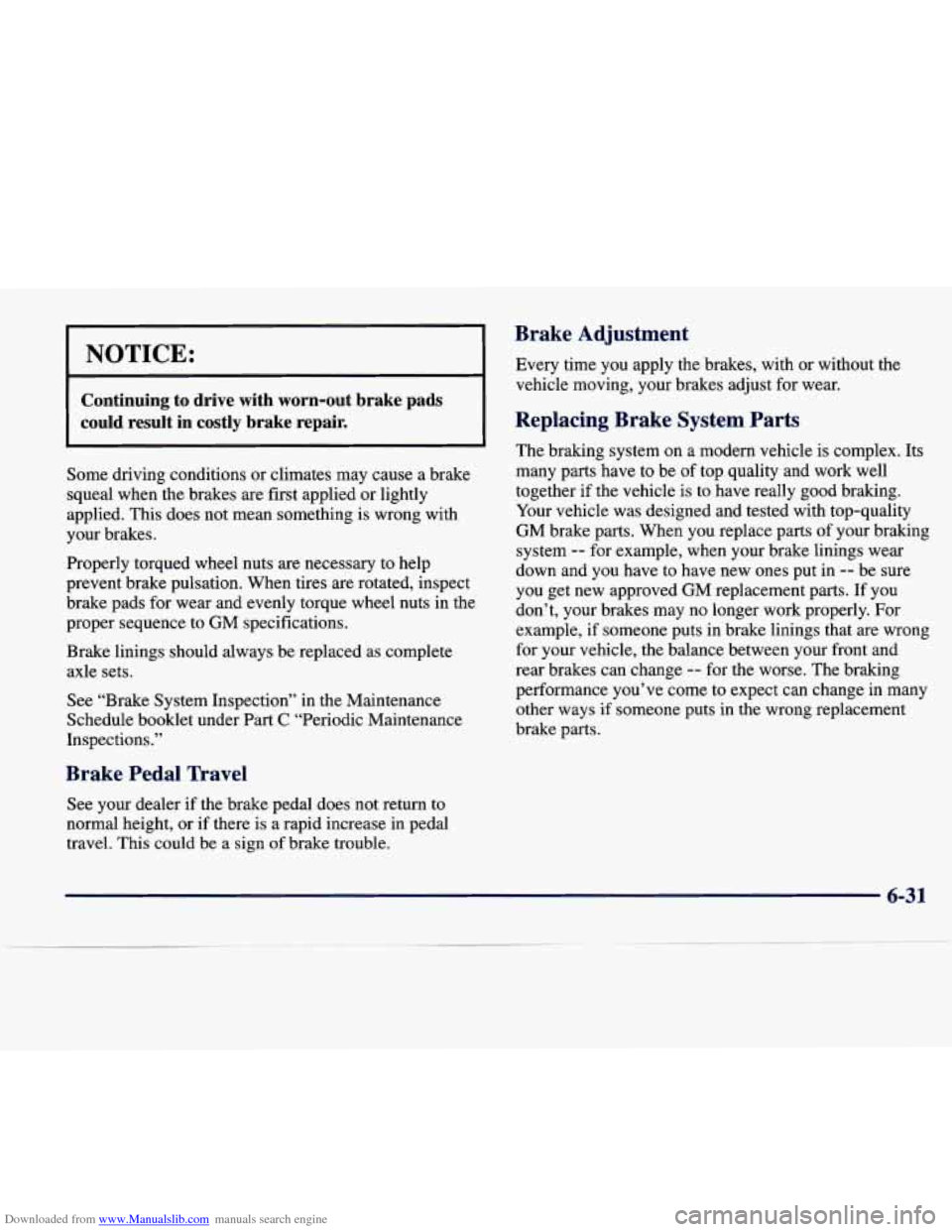
Downloaded from www.Manualslib.com manuals search engine NOTICE:
Brake Adjustment
Every time you apply the brakes, with or without the vehicle moving, your brakes adjust for wear.
Continuing to drive with worn-out brake pads
could result in costly brake repair.
Replacing Brake System Parts
The braking system on a modern vehicle is complex. Its
Some driving conditions or climates may cause a brake
squeal when the brakes are first applied or lightly
applied. This does not mean something is wrong with
your brakes.
Properly torqued wheel nuts are necessary to help
prevent brake pulsation. When tires are rotated, inspect
brake pads for wear and evenly torque wheel nuts in the
proper sequence to GM specifications.
Brake linings should always be replaced as complete
axle sets.
See “Brake System Inspection’’ in the Maintenance
Schedule booklet under Part
C “Periodic Maintenance
Inspections.”
Brake Pedal navel
See your dealer if the brake pedal does not return to
normal height, or if there is a rapid increase in pedal
travel.
This could be a sign of brake trouble. many parts have to be
of top quality and work well
together if the vehicle is to have really good braking.
Your vehicle was designed and tested with top-quality
GM brake parts. When you replace parts
of your braking
system
-- for example, when your brake linings wear
down and you have to have new ones put in
-- be sure
you get new approved GM replacement parts. If you
don’t, your brakes may no longer work properly. For
example, if someone puts in brake linings that are wrong
for your vehicle, the balance between your front and
rear brakes can change
-- for the worse. The braking
performance you’ve come to expect can change in many other ways
if someone puts in the wrong replacement
brake parts.
6-31